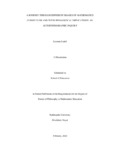
Please use this identifier to cite or link to this item:
https://hdl.handle.net/20.500.14301/452| Title: | A Journey Through Different Images of Mathematics Curriculum and their Pedagogical Implications: An Autoethnographic Inquiry |
| Authors: | Luitel, Laxman |
| Citation: | Luitel,L.(2020). A journey through different images of mathematics curriculum and their pedagogical implications: An autoethnographic inquiry. |
| Issue Date: | 2020 |
| Publisher: | Kathmandu University School of Education |
| Department: | DOSE |
| Level: | M.Phil. |
| Program: | MPhil in STEAM Educaiton |
| Abstract: | In my experience of teaching mathematics, I have been getting an opportunity to work together with the mathematics teachers from primary to secondary level as well as participating together in the training and workshop related to the uses and understanding of the mathematics curriculum. Correspondingly, as a student of mathematics, I have studied curricula and mathematics as a compulsory course in school life as well as university life. I was engaged in memorizing the definition of the curriculum instead of its practical implication. While doing so, I experienced that sometimes our curriculum serves the students’ need and interest and sometimes does not, sometimes it become contextual and sometimes it does not. Sometimes it challenges the teacher’s planning and activity design and sometimes it suggests incorporating more substances. However, as a student and a teacher, what I experienced and have been experiencing is textbook becomes the main source of teaching and learning. Planning is based on the textbook and mathematics curriculum is prepared by so-called ‘expert’ and is prescriptive in nature and is rarely applied in teaching learning activities. In this regard, the purpose of this research was to explore and critically investigate my images of mathematics curriculum and associated pedagogy. Side by side, I have discussed assessment practice guided by different images of mathematics curriculum. To direct my research, I have constructed four different research questions and chosen paradigms of interpretivism, criticalism and postmodernism (Taylor & Medina, 2013). Embracing the multi-paradigmatic design space, I employed autoethnography as a research methodology and writing as a research method for portraying my narratives and stories. I used Knowledge Constitutive Interest (Habermas, 1972), Transformative Learning Theory (Mezirow, 1991) and Social Constructivism (Vygotsky, 1978; Ernest, 1991) as theoretical referents. Mainly, I have divided this research into four sections to critically analyze dis/empowering images of mathematics curriculum. First, I have started my experiences of working with mathematical activities during my childhood when I did not start my formal education. Similarly, I have connected my informal mathematics to formal mathematics and official mathematics curriculum and constructed the images of mathematics curriculum as a textbook, curriculum as tools for testing human intelligence, curriculum as a list of contents, etc. Second, I have unfolded my experiences of learning mathematics as well as a curriculum as a university student when I was a Bachelor level student of mathematics in college. The pedagogical approach was oriented by coding and decoding aspects which was focused on memorization of definition of curriculum, theorems, axioms etc. In this regard, the images of mathematics curriculum as cultural reproduction, curriculum as prescription, etc. were constructed. Third, I have reflected on my initial experiences of teaching which was guided by my experiences of learning at school and college. I was busy implementing the component and essence of prescribed mathematics curriculum and became the Universalist as well as a foundationalist mathematics teacher. Curriculum as a textbook, curriculum as dollar-based document, curriculum as sequence of algorithmic problems, etc. were the constructed images of mathematics curriculum in which teaching was highly based on one-way narration. Fourth, I have explained how I came up with the empowering images of the mathematics curriculum. In this regard, curriculum as experiences, curriculum as a collection of art, curriculum as an interactive way of teaching and learning, etc. were the constructed images of the mathematics curriculum, likely to serve the essence of curriculum as cultural reconstruction, currere, as well experiences discussed by Schubert (1986). I have offered empowering and humanizing pedagogy focusing on indigenous mathematical knowledge as well as integrated curriculum that might help to enhance cultural aspects of mathematic, respect global as well as local aspect of mathematics and foster equality and equity in educational institutions and society for bringing inclusive and transformative vision of mathematics and mathematics curriculum. In this context, on the basis of experiences of learning mathematics education at Master’s as well as MPhil study at the university, participation in the conferences, workshop, seminar as well as interaction with students, I can argue that STEAM curriculum, as well as STEAM pedagogy, will be the appropriate to enhance the cultural aspects of mathematics, to value the students' experiences as well as to enhance the 21st century skills. |
| URI: | https://hdl.handle.net/20.500.14301/452 |
| Appears in Collections: | Dissertation |
Files in This Item:
| File | Description | Size | Format | |
|---|---|---|---|---|
| [Dissertation]Laxman_MPhil (1).pdf | 2.33 MB | Adobe PDF |  View/Open |
Items in DSpace are protected by copyright, with all rights reserved, unless otherwise indicated.